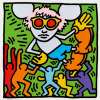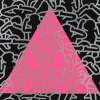 Andy Mouse 2 © Keith Haring 1986
Andy Mouse 2 © Keith Haring 1986
Interested in buying or selling
Keith Haring?
Market Reports
When selling a Keith Haring print, timing and pricing are key to achieving the best results. Haring, known for his bold graphic style and social commentary, was a defining force in late 20th-century art, shaping the intersection of street culture, pop art, and social activism. This seller's guide helps you determine the best time to sell and maximise the value of your print in today’s market.
Is Now A Good Time To Sell A Keith Haring Print?
2025 has marked a strong moment for the Haring market. Despite a slightly lower number of lots (57 versus 71 in H1 2024), total sales value climbed to £1.9 million, a 72% year-on-year increase. This lifted the average sale price to £34,300 – the second-highest on record for the artist. The figures reflect tightened supply, increased buyer competition, and a renewed focus on both iconic and undervalued works.
Hindman Auction Records (2025)
New records were recently set for two works at Hindman:
- Flowers (Yellow) – £28,652
- Flowers (Blue) – £26,264
The Flowers collection ranks among Haring’s highest‑valued and rarest series. While his prints have appeared at the major auction houses this year, these record results achieved at Hindman underscore both the breadth of his market and the increasing availability of Haring works across a wider range of venues.
The Highest Valued Haring Prints in 2025 and Growing Demand for Complete Sets
Several key events have underpinned the rise in Haring print values this year. In November 2024, Sotheby’s offered a group of previously unseen subway drawings in New York, sparking renewed attention around Haring’s market. This momentum continued into May 2025, when Sotheby’s presented five complete print sets from the Tony Shafrazi collection, adding a layer of prestigious provenance from Haring’s long-time dealer. Also the Fertility Suite just sold for £203,200 at Christie's in September.
Complete sets - particularly outside of his most widely circulated Pop Shop series - are relatively rare in the Haring print market. The sets offered - Icons, White Icons, Growing (TP), Flowers, and Fertility - have made only occasional appearances on the public market. Each achieved strong results, outpacing past sales of the same sets and demonstrating clear value growth. The top result came from Growing, which was presented as a complete set of trial proofs and achieved $762,000 (USD), making it the highest-priced Haring print sale of H1 2025.
Market Trends In American Pop Prints
These results underscore several trends within the American Pop print market: rising prices, growing demand for works with strong artist-related provenance, and increased collector appetite for complete sets - particularly those issued as special editions, trial proofs, artist’s proofs, or with matching edition numbers. For sellers, demand for these rarer configurations remains strong. In a market shaped by selectivity and reduced volume, complete sets appear to offer a notable degree of liquidity.
How Much Are Keith Haring Prints Worth?
Haring’s print market has shown continued strength for works that combine iconic imagery, rarity, and strong provenance. While demand spans a range of price points, the prints that consistently achieve the strongest results share several key characteristics.
What Are Haring's Most Recogniseable Symbols?
Works featuring Haring’s best-known symbols - barking dogs, radiant babies, dancing figures - remain the most sought after. Their flat, high-contrast colour and energetic linework have a universal appeal, and this recognisability underpins ongoing collector demand across both entry-level and investment-driven buyers.
Haring's Most Frequently Traded Works: Pop Shop Prints
The Pop Shop series remains a cornerstone of Haring’s print market, tied to the launch of the Pop Shop in 1986 as a direct extension of his democratic approach to art. It is the most actively traded segment of his print portfolio, issued in various formats - individual plates, quads, and complete sets. These works are sought after for their recognisability, accessibility, and strong market presence. For many collectors, they serve as foundational acquisitions, offering consistent liquidity for sellers.
Andy Mouse Market Trends and What’s Driving Value in Haring’s Top Prints
The Andy Mouse prints remain among Haring’s most valuable works. Infused with vibrant colours, playful energy, and iconic motifs, they embody everything Haring collectors are drawn to. Exceptionally rare, these prints also carry historic weight - each is signed by both Haring and Andy Warhol, to whom the series pays homage.
Although average values have dipped slightly in 2025, this reflects limited supply rather than a drop in demand. Following a wave of high-value sales in 2023 and 2024 - including several rare proofs - it’s typical for collections of this rarity and calibre to see a period of quieter market activity.
Meanwhile, collector attention has shifted toward other areas of Haring’s market. The Dog series, produced as both screenprints and cut-out sculptural editions in black, red, and yellow, has seen significant momentum. Special proofs have achieved auction results exceeding £100,000. Most recently, a black edition sold at Sotheby's May New York sales for $406,400 (USD).
What Seller's Need To Know About Keith Haring’s Edition Sizes
Haring’s edition sizes range from 25 to over 250, creating a tiered market that spans accessible to high-value works. While smaller editions suggest rarity, value is equally shaped by subject, format, and collector demand. For example, Apocalypse (ed. 90) remains relatively affordable, with most works under £15,000, while Chocolate Buddha – also ed. 90 – typically commands £17,000–£26,000 due to stronger alignment with Haring’s iconic style.
One unique aspect of Haring’s practice is his use of sculptural editions. Works like the Dog cutouts – produced in editions of 10 to 15 per colour – and aluminium prints like Pyramids or Radiant Baby are especially scarce and desirable.
At the opposite end, large-run exhibition posters (some numbered, many not) offer more affordable entry points, reflecting Haring’s commitment to accessible art.
Is a signature important for a Keith Haring print?
A signature is a key factor in determining both authenticity and value. Most prints are hand-signed “K. Haring” in cursive, numbered, and dated – often vertically along the margin or beneath the image, depending on the series. For example, the Stones series is signed in red ink directly below the image, while works from Growing and Pop Shop are typically signed along the right edge.
Some Pop Shop prints and quads bear the signature of Julia Gruen, Haring’s estate executor, on the reverse. These were issued around or after Haring’s death and are considered authenticated, though they usually command lower prices than works signed by Haring himself. For instance, Pop Shop Quad IV (1989) features Gruen’s signature, while Best Buddies (1990) is signed by both Gruen and Anthony Shriver.
The Andy Mouse series carries dual signatures from Haring and Andy Warhol – a rare pairing that significantly elevates both value and historical importance.
While placement and format vary by edition, confirming whether a print is hand-signed or estate-authenticated remains essential to establishing market value.
How To Authenticate Keith Haring Art
Authentication is crucial when selling a Haring print. Until 2012, the Keith Haring Foundation issued certificates of authenticity (COAs), but the programme ended due to legal concerns. Today, provenance and expert validation are key.
Trusted indicators include original sales invoices, exhibition records, and publication by recognised galleries such as Tony Shafrazi, Michael Kohn, or Leo Castelli. Works with this level of documentation tend to achieve stronger results.
The catalogue raisonné Keith Haring: Editions on Paper 1982–1990 by Klaus Littmann remains the go-to reference for verifying edition details. Though out of print, it’s accessible through institutional archives.
Visual analysis is equally important. Haring’s clean lines are often imitated, so expert review of ink, paper, composition, and signature is essential. Sellers should also note that only signed and numbered editions – or those published by the Foundation – are considered authentic; exhibition posters, while collectible, are valued differently.
Our team offers complimentary valuations and can assist in verifying details against current market standards.
How to care for a Keith Haring print
Condition significantly impacts the value of a Haring print. His vivid colours and crisp lines are especially vulnerable to light damage, making UV-protective glazing and professional framing essential. Avoid direct sunlight and poor-quality materials that can cause warping or surface damage over time.
Buyers often inspect the reverse for adhesive marks, restorations, or missing stamps – so maintaining both sides of the print is important.
If you’re unsure about condition, seek expert advice before cleaning or restoring. MyArtBroker can connect you with trusted conservation professionals – visit The Directory for specialist contacts.
For more on long-term care, watch our expert-led Live Panel on print conservation.
Ways to Sell with MyArtBroker
At MyArtBroker, we provide free valuations backed by real-time market data, helping you price your work accurately and identify the right time to sell.
Our live Trading Floor shows active demand, collector interest, and sales trends across the Keith Haring market – offering unmatched transparency. For deeper insight, our MyPortfolio tool tracks auction records and resale performance across more than 50,000 sales, giving sellers a full picture of their collection’s market position.
Private Sales With 0% Seller Fees
Unlike auction houses or general marketplaces, MyArtBroker is a specialist private sales platform built for high-value prints. Sellers pay 0% commission – we take a small buyer-side fee and cover all costs, including shipping, insurance, and marketing.
Each work is reviewed by our in-house experts, authenticated, and placed in front of a qualified collector base of over 30,000 active buyers. From rare proofs to iconic Pop Shop editions, we ensure your Keith Haring print gets the attention it deserves.
Trusted Advise & Tailored Support
If your work falls outside our core platform – due to price, condition, or format –we’ll still offer personalised advice and may recommend one of our trusted partners. Every print receives tailored guidance, with a focus on maximising your return.
Start with a free, no-obligation valuation and explore current listings on the Trading Floor.















